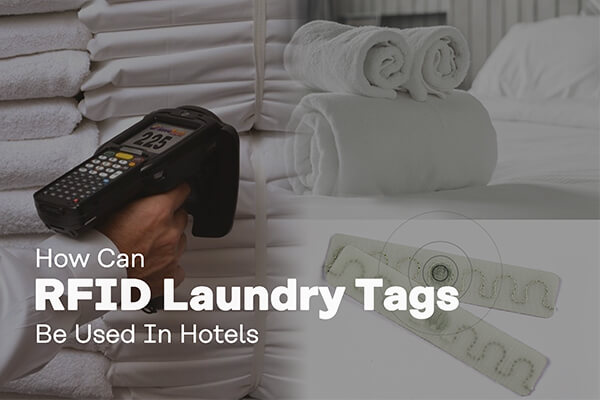One of the largest expenses of room occupancy in the hospitality industry is the growing cost of linen supplies. Hotels are in the dark when they’re being laundered by outside vendors and in the hands of customers. Storing enough extras and replacements take up valuable space and replacing high-quality linen can be expensive. Therefore, by implementing RFID laundry tags on these linens, hotels can now account for them. The linen has an RFID tag either sewn into the fabrics label or attached to the label and is scanned using the RFID scanner for accountability. With this, all concerned departments can view reports. The finance department for billing, housekeeping for wash cycles and inventory levels, and the purchasing department for order and life of linen.
How do RFID laundry tags work?
In the hospitality industry, the RFID laundry tags are encoded with information based on the hotels’ prefabricated rules in the RFID laundry chip and input the information in the background of the linen management system in place. This information is stored in a separate web-based software system database. When the linens are delivered to the laundry factory, the RFID reader automatically reads the UID number of each item through the scanning channel. These UID numbers are transferred over the network connection to the backend system where data is stored. The process indicates that linens have left the hotel and have been handed over to the laundry factory.
Before they are returned to the hotel after being cleaned, all UID numbers obtained through the RFID reader device are sent back to the system for comparison with the linen UID numbers sent to the laundry factory. This ensures a complete handover from the laundry factory to the hotel. Inside the hotel, the staff uses a handheld device to authenticate the linens received more accurately and efficiently. The RFID system can also provide a quick search function to track the status and location of the linen for fast-tracking.
Through the statistical analysis function of background data, the life analysis, washing condition, and any other data of every single linen can be accurately obtained. Its helpful for the hotel management to grasp the key indicators such as linen’s quality, and according to the analysis data, when the linen reaches the maximum number of cleaning times, the system can timely remind the staff to change.
Each linen supply is scanned and monitored to and from the laundry, in and out of linen closest/ stores, at the pool and beach kiosks, and at various check-in or check-out stations. This not only prevents theft but also allows hotels to make their workflow more efficient.
Benefits of RFID laundry tags
- Reduction in inventory time and labor
- Improved control and savings within the laundry process
- Improved customer service
- Increased life of linens and towels
- Reduction in linen and towel theft and shrinkage
- More efficient management of linen purchases
- Improved control over check-in and check-out process
Conclusion
RFID laundry tags can also have data on the cleaning method for particular linen and the tag can be read directly with an RFID reader, therefore, no hands are necessary especially when the linen is soiled. This hands-free benefit helps to keep staff safe and ensures good hygiene. Also, sorting and counting laundry by hand is both time-consuming and inaccurate. RFID readers can read hundreds of tags per second so laundry can be identified and tracked in bulk, automating the process and making it hands-free too.
Nexqo is expert in manufacturing RFID tags, click here to see how RFID laundry tags can be used in the industry.
Also, Nexqo is a professional hotel key card maker with more than 10 years of experience in the card-making industry. Click here to learn more about our RFID key cards which can also be used for contactless payment.
We have developed a new eco-friendly card that acts like a plastic card, BioPaper card. It can perfectly replace plastic cards. Click here to learn more about this material.
.png)
